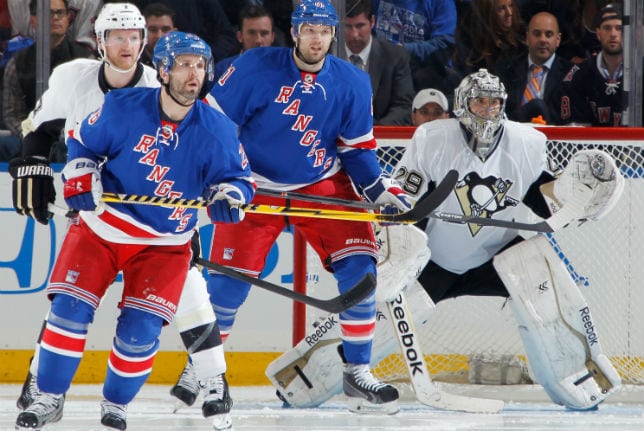
Season's over for Rangers, now it's time to look to the future
Rick Nash and Martin St-Louis (above) have been two of the bigger underachievers for the New York Rangers in this year's playoffs. Perhaps the time has come for the Rangers to consider using one of their compliance buyouts to part ways with Nash.
 Season's over for Rangers, now it's time to look to the future
Season's over for Rangers, now it's time to look to the futureWell, the New York Rangers have allowed the star players of the Pittsburgh Penguins to finally find their way in this series. But the reality is that players such as Sidney Crosby and Evgeni Malkin and Marc-Andre Fleury don’t even have to be that good. That’s because the bottom six forwards for the Penguins are outplaying the top six of the Rangers.
And as long as Crosby can keep absorbing the hits to the head from Marc Staal and his merry band of headhunters, the Penguins have basically punched their ticket to the Eastern Conference final. Any team that is down 3-1 to a group as talented and explosive as the Penguins is always in serious trouble. A team down 3-1 whose best player is Mats Zuccarello is basically finished.
Nothing against Zuccarello, but if he’s the best player for the Rangers, and he is, it means their highly-paid stars are not doing the job, which they’re not. Full marks to the Penguins for getting the job done, but this is a mediocre team they’re playing at the moment, one that would get ripped to shreds if it had to play in the Western Conference. Perhaps they’ll point to the fatigue factor – and if they’re still tired they should immediately fire their strength and conditioning coach – but this was a Ranger team that played with no urgency, no ability to handle the puck and no pushback. And that’s on the stars of this team, from Henrik Lundqvist out.
All in all, Game 4 was a pathetic effort from a team that fancies itself a contender in the Eastern Conference. But here’s the thing. The Rangers simply aren’t that good. They have a long way to go before becoming anything approximating a legitimate threat to win the Stanley Cup, or even come close. It’s probably safe to assume now that the first-round series between the Rangers and Philadelphia Flyers pitted the two worst teams in this year’s playoffs against one another.
And part of the problem for the Rangers is they remain their own worst enemy. Perhaps it would be different if the Rangers weren’t such a desired destination for players. Then it might not be tempted to try to grab every fading star player just because he happens to be available.
Think about it. Brad Richards came to the Rangers in 2011 on a nine-year deal. Other teams made more lucrative pitches to Richards, but he essentially had his heart set on playing for the Rangers. The moment Rick Nash waived his no trade clause with the Columbus Blue Jackets in 2013, it was basically assumed that the Rangers were going to get him. And when Martin St-Louis sulked his way out of Tampa Bay prior to the trade deadline, it was to go to one team and one team only – the Rangers.
Each of those acquisitions has been nothing short of a disaster so far. Nash, who had a dreadful game and an equally dreadful playoff for the Rangers, is now getting booed every time he touches the puck. In his own building. Nash has actually been contributing in his own end of the ice, but so does Anze Kopitar and it doesn’t stop him from creating offense. Since the 2006 Olympics, Nash has played a combined 45 Olympic and NHL playoff games and has four goals. Richards has scored some and had a pretty good first season in New York in both the regular season and the playoffs, but seems to be on the decline and is the point man on a power play that hasn’t scored in its past 38 opportunities. And St-Louis? Three goals in 30 regular season and playoff games since coming to the Rangers.
Which brings us to the future of this team. Yes, it’s time to start looking to the future. The Rangers have $54.9 million committed to salaries for next season. They have only four regular defensemen – Ryan McDonagh, Staal, Dan Girardi and Kevin Klein – signed for next season. Up front, Derick Brassard and Chris Kreider are restricted free agents.
So, the question must be asked. On which of Nash or Richards should the Rangers use their remaining compliance buyout? Knowing them, probably not either, but it would rid the Rangers of one onerous contract. If it were Richards, the Rangers would be forced to pay $18 million in real money since $33 million of his $60 million deal has already been paid out, but would have a cap savings of $6.7 million for the next six seasons. If they were to buy out Nash, it would cost them $21.3 million in real dollars and would save them $7.8 million against the cap for each of the next four seasons.
In our annual Future Watch issue, THN ranked the Rangers dead-last in terms of its group of prospects. Which means the Rangers are far closer to a tear-down than they are a Stanley Cup championship. Perhaps it’s time to begin that process now.



